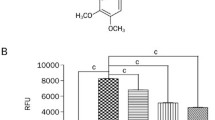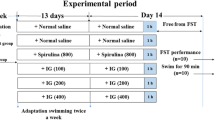Abstract
Introduction
It has been reported that various plant species may enhance the elimination of fatigue-related metabolites. However, relatively few studies have directly addressed the potential anti-fatigue effects.
Objective
The objective of this study was to investigate the anti-fatigue potential of a hot water extract of Sasa quelpaertensis Nakai leaf (SQH) in male ICR mice.
Methods
The animals were divided into three groups. The normal control (NC) group was administered saline without exercise every day for 7 days. The exercise control (EC) and exercise with SQH (ES) groups were administered saline and SQH (50 mg/kg of body weight), respectively, every day for 7 days and underwent swimming exercise. RNA sequencing technology was used to analyze the transcriptome profiles of muscle.
Results
Swimming times were prolonged in the ES group compared with the EC group. The ES group had higher blood glucose and lower blood lactate levels, and higher muscular glycogen and lower muscular lactate levels, compared with the EC group. The groups did not differ in histopathological parameters of the muscle and liver, but muscle cell sizes were smaller in the EC group than in the ES and NC groups. RNA sequencing analysis revealed that SQH administration regulated genes associated with energy-generating metabolic pathways in skeletal muscle.
Conclusion
These results suggest that SQH exerts anti-fatigue properties by balancing various biological systems and helping maintain the basic harmonious pattern of the body.




Similar content being viewed by others
References
Belluardo N, Westerblad H, Mudo G, Casabona A, Bruton J, Caniglia G, Pastoris O, Grassi F, Ibanes CF (2001) Neuromuscular junction disassembly and muscle fatigue in mice lacking neurotrophin-4. Mol Cell Neurosci 18:56–67
Chung WS, Kim SS, Oh JK, Lee JH, Kim KW, Jo YK, Yeon CH, Lee JS (2012) Anti-fatigue effect of fermented deer velvet antler extract in Sprague-Dawley rats. J Korean Rehabil Med 22:11–22
DeVol DL, Rotwein P, Sadow JL, Novakofski J, Bechtel PJ (1990) Activation of insulin-like growth factor gene expression during work-induced skeletal muscle growth. Am J Physiol 259:E89–E95
Dohm GL, Tapscott EB, Barakat HA, Kasperek GJ (1983) Influence of fasting on glycogen depletion in rats during exercise. J App Physiol 55:830–833
Gentleman RC, Carey VJ, Bates DM, Bolstad B, Dettling M, Dudoit S, Ellis B, Gautier L, Ge Y, Gentry J, Hornik K, Hothorn T, Huber W, Iacus S, Irizarry R, Leisch F, Li C, Maechler M, Rossini AJ, Sawitzki G, Smith C, Smyth G, Tierney L, Yang JY, Zhang J (2004) Bioconductor: open software development for computational biology and bioinformatics. Genome Biol 45:R80
Glass DJ (2003) Signalling pathways that mediate skeletal muscle hypertrophy and atrophy. Nat Cell Biol 5:87–90
Hardie DG, Sakamoto K (2006) AMPK: a key sensor of fuel and energy status in skeletal muscle. Physiology 21:48–60
Hsiao CY, Hsu YJ, Tung YT, Lee MC, Huang CC, Hsieh CC (2018) Effects of Antrodia camphorata and Panax ginseng supplementation on anti-fatigue properties in mice. J Veter Med Sci 80:284–291
Hulmi JJ, Tannerstedt J, Selanne H, Kainulainen H, Kovanen V, Mero AA (2009) Resistance exercise with whey protein ingestion affects mTOR signaling pathway and myostatin in men. J Appl Physiol 106:1720–1729
Hwang JH, Choi SY, Ko HC, Jang MG, Jin YJ, Kang SI, Park JG, Chung WS, Kim SJ (2007) Anti-inflammatory effect of the hot water extract from Sasa quelpaedensis leaves. Food Sci Biotech 16:728–733
Jagoe RT, Goldberg AL (2001) What do we really know about the ubiquitin-proteasome pathway in muscle atrophy? Curr Opin Clin Nutr Metab Care 4:183–190
Jiang X, Chu L, Qin L, Hao J, Kou L, Lin F, Wang D (2018) The anti-fatigue activities of Tuber melanosporum in a mouse model. Exp Ther Med 15:3066–3073
Jin HM, Wei P (2011) Anti-fatigue properties of tartary buckwheat extracts in mice. Int J Mol Sci 12:4770–4780
Kang SI, Shin HS, Kim HM, Hong YS, Yoon SA, Kang SW, Kim JH, Ko HC, Kim SJ (2012) Anti-obesity properties of a Sasa quelpaertensis extract in high-fat diet-induced obese mice. Biosci Biotechnol Biochem 76:755–761
Kim KM, Kim YS, Lim JY, Min SJ, Shin JH, Ko HC, Kim SJ, Lim YS, Kim Y (2014) Sasa quelpaertensis leaf extract suppresses dextran sulfate sodium–induced colitis in mice by inhibiting the proinflammatory mediators and mitogen-activated protein kinase phosphorylation. Nutr Res 34:894–905
Kurokawa T, Itagaki S, Yamaji T, Nakata C, Noda T, Hirano T, Iseki K (2006) Antioxidant activity of a novel extract from bamboo grass (AHSS) against ischemia-reperfusion injury in rat small intestine. Bio Pharm Bull 29:2301–2303
Langmead B, Salzberg SL (2012) Fast gapped-read alignment with Bowtie 2. Nat Math 9:357–359
Lee JY, Ko HC, Jang MK, Kim SJ (2016) Preparation and characterization of phytochemical-rich extract from Sasa quelpaertensis leaf. J Life Sci 26:1330–1335
Li Q, Wang Y, Cai G, Kong F, Wang X, Liu Y, Yang C, Wang D, Teng L (2015) Antifatigue activity of liquid cultured tricholoma matsutake mycelium partiall via regulation of antioxidant pathway in mouse. Biomed Res Int 2015:563245
Okabe S, Takeuchi K, Takagi K, Shibata M (1975) Stimulatory effect of the water extract of bamboo grass (Folin solution) on gastric acid secretion in pylorus-ligated rats. Jap J Pharm 25:608–609
Quinlan AR, Hall IM (2010) BEDTools: a flexible suite of utilities for comparing genomic features. Bioinformatics 26:841–842
Shao JT, Wang MY, Zheng LB (2013) Antifatigue effects of Gracilaria eucheumoides in mice. Exp Ther Med 6:5327–5337
Sun S, Niu H, Yang T, Lin Q, Luo F, Ma M (2014) Antioxidant and anti-fatigue activities of egg white peptides prepared by pepsin digestion. J Sci Food Agric 94:3195–3200
Suzuki S, Saito T, Uchiyama M, Akiya S (1968) Studies on the anti-tumor activity of polysaccharides. I. Isolation of hemicelluloses from Yakushima-bamboo and their growth inhibitory activities against sarcoma-180 solid tumor. Chem Pharm Bull 16:2032–2039
Tanaka M, Nakamura F, Mizokawa S, Matsumura A, Nozaki S, Watanabe Y (2003) Establishment and assessment of a rat model of fatigue. Neurosci Lett 352:159–162
Winder WW, Hardie DG (1996) Inactivation of acetyl-CoA carboxylase and activation of AMP-activated protein kinase in muscle during exercise. Am J Physiol 270:E299–E304
Yang Q, Jin Q, Lv X, Dai P, Ao Y, Wu M, Yu L (2016) Effects of macamides on endurance capacity and anti-fatigue properties in prolonged swimming mice. Pharm Biol 54:827–834
Yeh TS, Hsu CC, Yang SC, Hsu MC, Liu JF (2014a) Angelica sinensis promotes myotube hypertrophy through the PI3K/Akt/mTOR pathway. BMC Complement Altern Med 14:144
Yeh TS, Huang CC, Chuang HL, Hsu MC (2014b) Angelica sinensis improves exercise performance and protects against physical fatigue in trained mice. Molecules 19:3926–3939
Yoon SA, Kang SI, Shin HS, Kang SW, Kim JH, Ko HC, Kim SJ (2013) -Coumaric acid modulates glucose and lipid metabolism via AMP-activated protein kinase in L6 skeletal muscle cells. Biochem Biophys Res Commun 432:553–557
You Y, Kim K, Yoon HG, Choi KC, Lee YH, Lee J, Jun W (2015) Sasa borealis extract efficiently enhanced swimming capacity by improving energy metabolism and the antioxidant defense system in mice. J Nutr Sci Vitaminol 61:488–496
Zhao YQ, Zeng L, Yang ZS, Huang FF, Ding GF, Wang B (2016) Anti-fatigue effect by peptide fraction from protein hydrolysate of croceine croaker (Psedosciana crocea) swim bladder through inhibiting the oxidative reactions including DNA damage. Mar Drugs 14:221
Acknowledgements
This research was supported by Basic Science Research Program through the National Research Foundation of Korea (NRF) by the Ministry of Education, Science and Technology (2017R1D1A3B03029845), Republic of Korea.
Author information
Authors and Affiliations
Corresponding author
Rights and permissions
About this article
Cite this article
Song, H., Jang, M.G., Lee, J.Y. et al. Sasa quelpaertensis leaf extract mitigates fatigue and regulates the transcriptome profile in mice. Genes Genom 41, 317–324 (2019). https://doi.org/10.1007/s13258-018-0765-2
Received:
Accepted:
Published:
Issue Date:
DOI: https://doi.org/10.1007/s13258-018-0765-2




